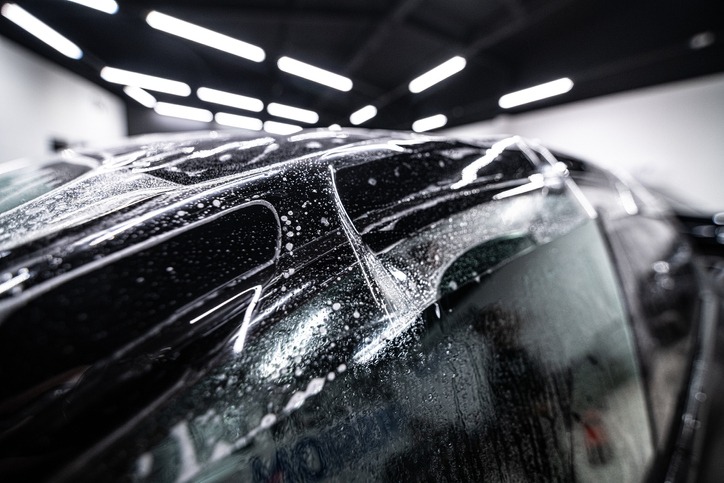Your car is more than just a mode of transportation – it’s an investment. Naturally, you want to protect and maintain its appearance, ensuring it retains its value over time. One effective way to safeguard your vehicle’s paint and finish is through Paint Protection Film (PPF). Address the most common questions regarding PPF by learning about its benefits, installation process, maintenance, and much more.
What is Paint Protection Film (PPF)?
Understanding PPF
Paint Protection Film, often referred to as clear bra or simply PPF, is a clear, thin, and flexible layer of polyurethane material designed to protect your car’s paint from various forms of damage. It is an invisible shield, guarding against chips, scratches, stains, and UV damage.
How Does PPF Work?
PPF is engineered to absorb the impact of debris, small rocks, and other road hazards that could otherwise chip or scratch your vehicle’s paint. Its self-healing properties mean minor scratches and swirls disappear over time, maintaining the car’s pristine appearance.
Benefits of Using PPF
Protection Against Road Hazards
One of the primary benefits of PPF is its ability to protect your car’s paint from road debris, such as stones, gravel, and sand. These materials can cause unsightly chips and dings in your paint, which PPF can help prevent.
UV Security
PPF provides excellent UV protection, shielding your vehicle’s paint from the sun’s harmful rays. UV exposure can lead to paint fading, oxidation, and dullness. PPF helps maintain your car’s colour and finish.
Self-Healing Properties
Many PPFs have self-healing properties, meaning minor scratches and swirls on the film’s surface disappear when exposed to heat, such as sunlight or warm water. This feature keeps your vehicle looking pristine even after small incidents.
Preserving Resale Value
Protecting your car’s paint from damage, PPF helps preserve its resale value. A well-maintained exterior can significantly impact the final selling price when upgrading or selling your vehicle.
Frequently Asked Questions about PPF
#1: How is PPF Installed?
PPF installation is a precise and meticulous process. It involves cleaning and preparing the vehicle’s surface, custom-cutting the film to fit each panel, and then applying it carefully. Professional installers use specialized tools to ensure a smooth and bubble-free application. The entire process can take several hours to complete, depending on the complexity of the vehicle.
#2: Is PPF Permanent?
PPF is not permanent and can be removed without damaging the vehicle’s paint. However, it is designed to be durable and long-lasting, typically offering protection for several years. The lifespan of PPF depends on factors like the quality of the film, environmental conditions, and how well it’s maintained.
#3: Can PPF Be Applied to Any Vehicle?
PPF can be applied to most vehicles, including cars, trucks, SUVs, and motorcycles. It is often customized to fit the specific make and model of the vehicle, ensuring a precise and seamless appearance.
#4: Does PPF Affect the Vehicle’s Appearance?
When professionally installed, PPF is virtually invisible. It maintains the original appearance of your vehicle while providing protection. The film is designed to be clear and glossy, ensuring that your car’s aesthetics remain intact.
#5: Can I Wash and Wax My Car with PPF?
You can wash and wax your car with PPF like any other vehicle. Waxing can enhance the gloss and longevity of the film. However, it’s essential to use non-abrasive products and avoid using rotary buffers on PPF.
#6: How Does PPF Compare to Ceramic Coatings?
PPF and ceramic coatings serve different purposes. PPF offers physical protection against impacts and scratches, while ceramic coatings provide chemical resistance and hydrophobic properties, making them easier to clean and maintain. Some car owners choose to combine both for comprehensive protection.
#7: Can PPF Be Repaired if Damaged?
Minor damage to PPF, such as small tears or scratches, can often be repaired. Professional installers have the expertise to assess the damage, apply patches, or perform spot repairs to maintain the film’s integrity.
Maintenance & Care
Regular Cleaning
Regular cleaning is essential to maintain the appearance and effectiveness of PPF. Use a mild automotive detergent and a soft microfiber cloth to wash your vehicle. Avoid abrasive materials and harsh chemicals that could damage the film.
Waxing
As mentioned earlier, waxing your car with PPF is beneficial. It adds an extra layer of protection and enhances the film’s gloss. Choose a high-quality automotive wax that is compatible with PPF.
Avoid Parking Under Trees
Tree sap and bird droppings can be challenging to remove and may damage PPF if left on the surface for an extended period. Whenever possible, park your vehicle away from trees to reduce exposure.
Regular Inspections
Periodically inspect your PPF for any signs of damage or wear. Address any issues promptly to prevent further damage and maintain the film’s protective qualities.
Professional vs. DIY Installation
Professional Installation
Professional installation is highly recommended for PPF. Certified installers have the training, experience, and equipment to ensure a flawless application. They can also provide warranties on their work and the film itself.
DIY Installation
While some DIY kits are available, applying PPF can be challenging, and the results may not be as satisfactory as professional installation. During installation, mistakes can lead to bubbles, creases, and misalignment.
Paint Protection Film (PPF) is a valuable investment for vehicle owners looking to preserve their car’s paint and finish. It offers protection against road hazards, UV damage, and minor scratches while maintaining the vehicle’s aesthetics. By addressing common questions about PPF and understanding its benefits, installation process, and maintenance requirements, you can decide to protect your vehicle’s resale value and keep it looking its best for years.
